 |
New York
Architecture Images-Greenwich Village Elmer Holmes Bobst Library and Study Center |
|
architect |
Philip Johnson & Richard Foster |
|
location |
70 Washington Square South. |
|
date |
1968-72 |
|
style |
International Style II |
|
construction |
Brownstone |
|
type |
Education |
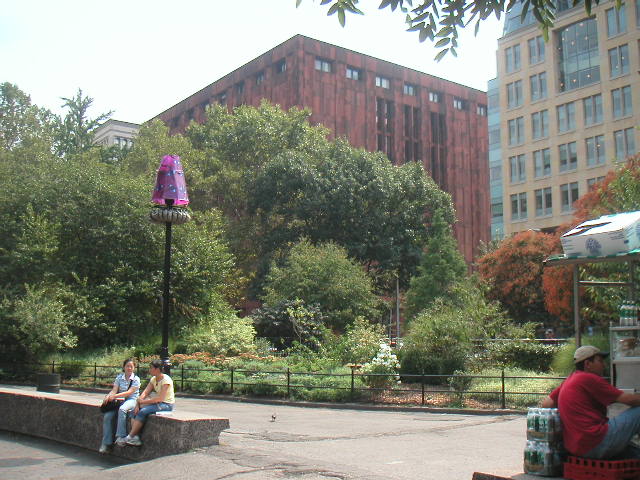 |
|
|
images |
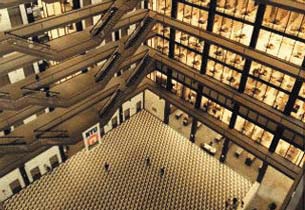 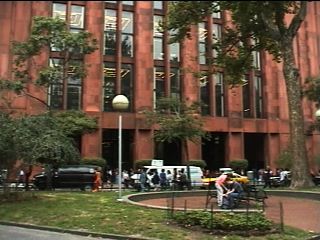 |
|
|
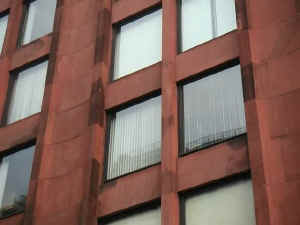 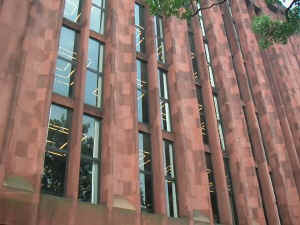 |
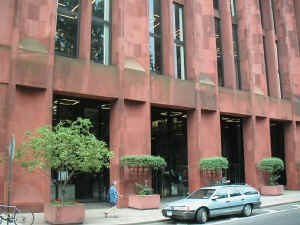 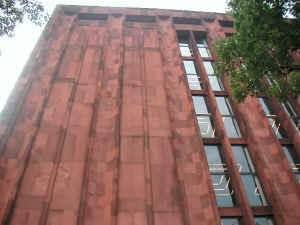 |
|
 |
|
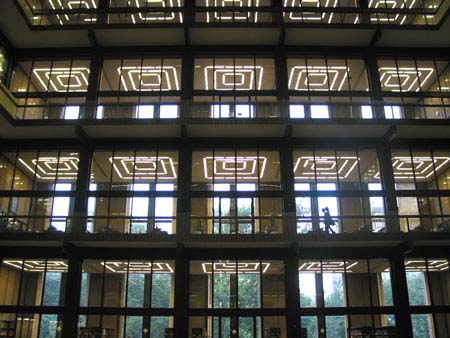 |
|
| Images thanks to Bluejake. | |
|
notes |
One of four
buildings executed for the university by Philip Johnson (a highly
influential architect of the 20th century), Bobst Library was part of the
unrealized NYU Campus Master Plan by Johnson and Foster. Although its red
sandstone facade reveals the architects' attempt to work within the context
of Washington Square, the large-scale building towers over the surrounding
buildings. Its lack of applied ornament and formal expression of the steel
frame are features of modern architecture. At the same time, its fluted
masonry cladding, enormous Palladian atrium and elaborate first floor
pattern are historicist references that characterize postmodern buildings.
NYU's main library, built in 1972 to a Philip Johnson design; at the time, the plan was to redo all of NYU in this red sandstone look. Named for Nixon supporter, anti-Semite and child molester Elmer Holmes Bobst; a corrupt contribution from Bobst to Nixon is supposedly responsible for the selection of Spito Agnew as Nixon's running mate. Lili Taylor studied here in The Addiction. At least two real-life NYU students have committed suicide by leaping down the central atrium. If you want to go inside, tell the guard that you're going to the Tamiment Labor Library on the 10th floor, which unlike the rest of the library is open to the public. The southeast corner of the library is the site of Open Door, where jazz legends like Charlie Parker and Miles Davis played. "interesting fact about the NYU library: if you stand on the top floor (south side) and gaze downward you may not feel the urge to kill yourself anymore. it was purposely designed to reduce suicide jumpers. if you look at the tops of the metal gates on each floor they are designed to look like crosses while the floor was designed to look like spikes that are far away. it was, of course, inspired by MC Escher’s drawing “Depth.” |
|
By ALLEN SALKIN Call it the “Atrium of Horror.” The N.Y.U. Library, called “Bobst” for someone who gave money to help build it, is a terribly designed, dangerous, vertigo-inducing, ugly structure with more space for air than books. The building is basically a shell that encases a 10-story-high vacuum, a soulless, hard-floored atrium of horror. Why this attack on a library? Two suicide leaps in the past month by undergraduates inside the atrium. They didn’t have to happen. Anyone who has ever walked along the railing at the atrium’s edge on Bobst’s upper floors is stunned by the optical-illusion floor far below (do the squares recede or come towards the eye?) and the shortness of the rails. A recent piece in the New Yorker about the 1,200-plus suicides from the Golden Gate Bridge points out that suicidal moods are often short lived. Take away the option of a perfect place to commit the act and a person might pause long enough to think twice. But Bobst speaks the cold language of suicide. Its design is early-1960s modern heartless. Brutal geometry. Humans are specks in its cruelly soaring spaces. Step through the revolving doors into it, look up at the thin walkways along the atrium’s edge and one thought naturally occurs: “A fall from there will kill.” More surely than a bottle of pills, a razor blade or a gunshot. Philip Johnson is the most overrated architect in the history of architecture and this red monstrosity of his proves it. I teach journalism at N.Y.U., so I am biting the hand that feeds me to write this. But that hand has blood on it for ever building this structure and for not having higher barriers around the balconies. N.Y.U. won’t knock it down because replacing it would cost too much and Johnson’s reputation is so sacred. In an e-mail on the suicides to the campus community sent the Monday afternoon after the second library suicide (Oct. 14, 2003), N.Y.U. President John Sexton noted that “the search for a rational cause, so instinctive in a community defined by its commitment to ideas, is a fruitless undertaking.” Later in the e-mail he defended Bobst as a “house of knowledge,” and wrote that we should not “permit our thoughts to be dominated [by the suicides] each time we enter and use the library.” What will help is if there are no more plunging bodies, something that Sexton’s “rational” pledge to install tall glass panels around the railing should ensure. But I for one will never forget those dead students, nor that a community defined by its commitment to ideas ever built a building so irrational that it would one day require glass suicide barriers. The Villager,
Volume 73, Number 25 | October 22 - 28, 2003 |
|
|
N.Y.U. reacts to second Bobst leap within a
month
By Rebecca Sun, Neil Parmar, Erin Walsh and Albert Amateau The suicides of two students in less than four weeks have brought New York University to national attention and have forced the school’s administration to address its treatment of suicide, both preventively and in the aftermath. Freshman Stephen Bohler jumped to his death from the 10th floor of N.Y.U.’s Bobst Library on Oct. 10, police said. The incident occurred exactly four Fridays after John Skolnik, a 20-year-old junior, leaped from the library’s 10th floor. Bohler, 18, a resident of Irvine, Calif., who grew up in Dayton, Ohio, gave no sign to fellow students that he was contemplating suicide, according to reports. While the university dealt with Skolnik’s Sept. 12 death quietly, setting up emergency counseling sessions for students and staff, Bohler’s death brings the two cases to a much higher level of scrutiny. Over the weekend, the national media Web site, Drudge Report, posted a link to N.Y.U.’s daily student newspaper, consequently flooding its server. On-campus reaction to Friday’s death was also much stronger compared to last month. Todd Allen, a 31-year-old graduate student, was at the library during both suicides. He criticized N.Y.U. officials for the lack of coverage of Skolnik’s death. “There wasn’t any mention [of his death] in classes and there weren’t any notices sent out to students. There wasn’t even a candlelight vigil,” said Allen. “I understand it’s a new phenomenon, but it’s happened twice now. One more time and it’s a fad.” On Friday evening, N.Y.U. administration sent an e-mail informing the university community of Bohler’s suicide and offered emergency counseling services to those in need. “There is a support system to help students
’round the clock at N.Y.U.… Don’t ever feel reluctant to use them if you
need them, or to urge a friend to make use of them,” wrote Marc Wais,
vice president for student affairs. Counselors from the University Counseling Service were on call over the weekend at both Bobst Library and Rubin Residence Hall, 35 Fifth Ave., where Bohler lived. Professors from N.Y.U.’s Ehrenkranz School of Social Work also volunteered their time to counsel librarians, staff members and students. Consuelo Martagh, a senior counselor with
the Faculty and Staff Assistance Program, expressed concern over the two
suicides that occurred within such a short period of time. She
acknowledged the difficulty of catching warning signs before suicides
occur and added, “It’s the nature of the act that leaves you wanting for
answers.” “It’s almost as if someone is inviting you to their suicide,” she said. “As a young person now, this is a very impressionable time in their lives,” Fleming added. “Some people don’t develop the mechanisms to survive. In college, you’re just a little more vulnerable because you’re still negotiating a sense of self.” Bohler’s death has already created tangible responses by the university. Its e-mail statement read, “The university is implementing a number of measures we deem prudent in response to this tragic episode to increase everyone’s safety.” The Washington Square News, N.Y.U.’s student newspaper, reported that the administration had erected temporary barriers on the library’s upper balconies. Security guards were stationed at some balcony points over the weekend, and John Beckman, spokesperson for the university, said tall glass barriers would be installed within the next few weeks on the upper walkways. “The university will be taking measures that it feels are prudent and appropriate,” Beckman said. Abby Aronofosky, W.S.N.’s managing editor, said her understanding was that barriers would be installed from the third floor up and that they would be floor to ceiling. Beckman said he couldn’t say if the barriers will be floor to ceiling. According to the university, last month’s suicide plunge was the first in Bobst’s 30-year history. The building, designed by Philip Johnson and Richard Foster, was completed in 1973 on the southeast corner of Washington Sq. Park. It holds 3.3 million volumes, draws more than 6,000 people on an average school day and its large atrium is often used for university convocations. The Villager, Volume 73, Number 24 | October 15 - 21, 2003 NYU Shaken by Suicide Jumpers at Bobst LibraryExtra security guards have been posted at New York University’s 12-story Elmer Holmes Bobst Library while construction workers installed glass walls to enclose the library’s interior balconies where two students recently leaped to their deaths in separate cases of apparent suicide. Stephen Bohler, an 18-year-old freshman from Dayton, Ohio, reportedly threw himself onto the library atrium’s marble floor October 10 after climbing over an upper-story ledge. John D. Skolnik, a 20-year-old junior from Evanston, Illinois, died September 12 as students watched him fall from the 10th-floor balcony. Calling the deaths “devastating” and “unfathomable,” NYU President John Sexton said in an October 13 memo that “aggressive measures must be taken to protect us against such traumas,” according to the October 14 New York Daily News. “We need to reassert for the library the central role it fulfills in this community of scholars.” University spokesman John Beckman said in the October 11 New York Times that the school was providing counselors at the library and was preparing to take “a number of steps” to address issues around the deaths. An NYU spokesperson said these were apparently the first suicides in the 30-year-old library. Posted October 20, 2003. |
|
|
Skint student sleeps in library
A
student in the US has been given free accommodation after it was
discovered that he had been sleeping in the college library for eight
months to save money. © Copyright of The National Student 2004 |
|